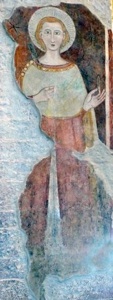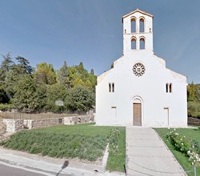
This Romanesque church was built on the site of the baths that once formed part of the pan-Umbrian Sanctuary, which later became a Christian cemetery.
The church was documented in 1178 as a dependency of the Abbazia di San Silvestro. This abbey was suppressed in 1236 and San Claudio disappears from recorded history until ca. 1389, when an “Fiera Franca” (French fair) was instituted here, probably at the behest of Pandolfo Baglioni.
In 1392, Pope Boniface IX granted a plenary indulgence to all of those visiting San Claudio on the day of the fair (29th August, the feast of the beheading of St John the Baptist). This indulgence was based on the so-called Perdonanza dell’ Aquila, which Pope Celestine V had granted to those visiting the church at Aquila in which he had been crowned on the anniversary of the event. This was an extraordinary development that Boniface IX had tried to reverse, but he later found the practice to be a useful way of making friends and raising money! He was, however, forced to revoke all such indulgences in 1402.
Despite the short life of the indulgence, the fair itself became a popular civic event and San Claudio became a civic church. In 1393, the Commune commissioned Cola Petruccioli to execute an important series of frescoes (see below). A loggia was built along the sides of the church in 1487 to accommodate stall holders, but it was subsequently demolished.
Another important fair that is still held at Spello is associated with St Claudius: the Fiera delle Fantelle, on November 8th, during which girls ready for marriage (fantelle) might hope to find a husband. This is the feast of SS Claudius, Nicostratus, Symphorian, Castorius, and Simplicius, five sculptors who were martyred in Pannonia under the Emperor Diocletian. (This page on Wikipedia sets out the confusion surrounding these saints). While it is not clear to which of the many saints called Claudius this church was originally dedicated, it is certain that by 1393 the saint in question was this one (depicted in the church on that date and thereafter as the patron of stone masons).
The church has suffered from a series of earthquakes, most recently in 1997, and is newly restored. Remains found outside the church during the excavations of 2001 related to: the Roman baths; a medieval cemetery and the loggia (1487) built for the market.
Exterior
The façade has three portals, two of which are now closed, with a central rose window and two bifore windows above. (The fine rose window is a reconstruction.) The upper part of the façade accommodates two orders of bells.
Interior
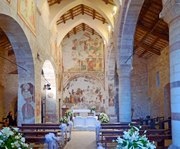
Inside the church, two arcades of arches of diminishing height separate the nave from the aisles; the arches on the left are separated by brick piers and those on the right by columns.
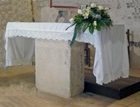
An inscription that was found in the Roman amphitheatre in 1958-9, which was moved to San Claudio, reads:
. . .IVS/ COLONIAE HIS[PELLI] . . . / PECVNIA SV[A] ....
This presumably identified the person who paid for the amphitheatre. He might well be Caius Alfius Rufus, who is also recorded in an inscription (CIL IX 5278) that is now embedded in the facade of San Lorenzo. This inscription, which is illustrated in Lacuscurtius), has been removed from the church for restoration.
Frescoes (1393)
As noted above, the Commune commissioned an important series of frescoes immediately after the granting of the plenary indulgence to those visiting the church during the fiera franca. These frescoes are attributed to Cola Petruccioli, who produced signed works in Spello at this time.
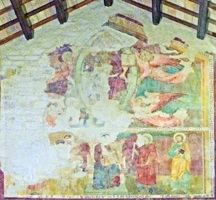
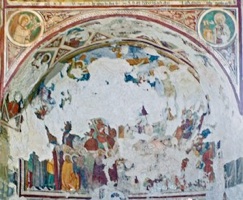
This work almost certainly included the frescoes in the apse, which depict:
-
✴Christ in a mandorla supported by four angels;
-
✴the Madonna and Child enthroned with SS James, John the Baptist, Claudius and Matthew below it, with the date inscribed below the figure of St Claudius;
-
✴the figures of the Annunciation in tondi in the spandrels above the niche below; and
-
✴the Crucifixion, in the niche ehind the high altar.
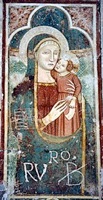
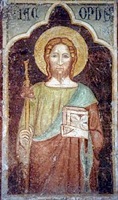
It may well have included the frescoes on the pilaster to the right of the apse, which depict:
-
✴the standing Madonna and Child; and
-
✴St James, with his pilgrim’s staff, below it; and

It may also have included six pairs of saints in rectangles above the arches on the left of the nave, each of which represented one of the confraternities of Spello. The most complete are those above the middle arch, which probaly relate to the confraternities of:
-
✴Santa Croce and Sant’ Andrea; and
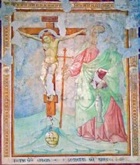
-
✴Santa Maria Maggiore and Sant’ Angelo.
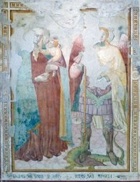
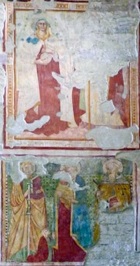
St Claudius (15th century)
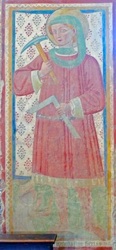
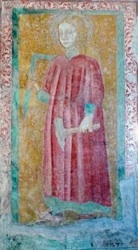
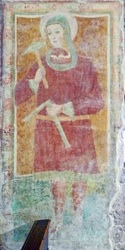

Four of the frescoes on the arches on the left represent St Claudius:
-
✴two on the 1st arch on the left (to the left above), one of which (at the extreme left above) has an inscription along the bottom that records that Antonio Antonelli commissioned it in 1482; and
-
✴two on the 2nd arch on the left.





